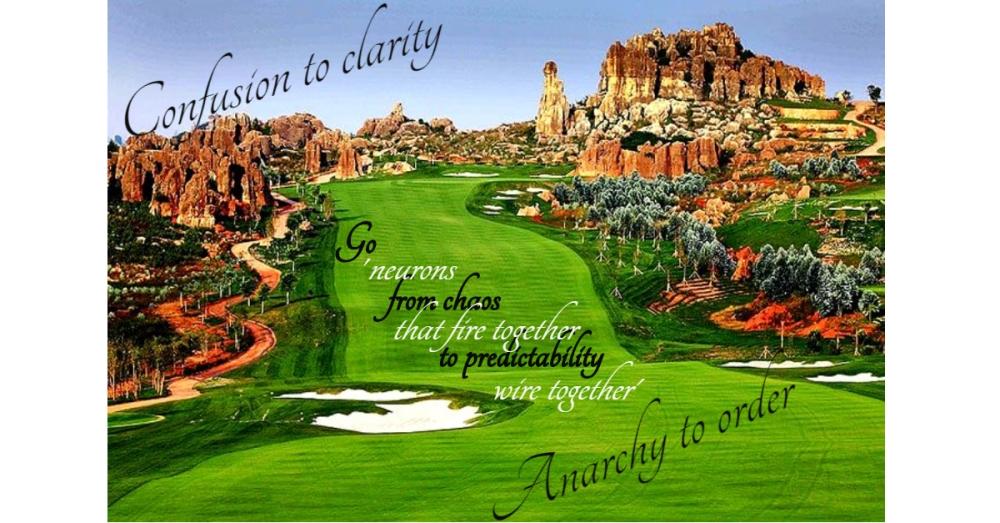CONTACT US

Improve the predictability of your golf shots in just 2 commonsense ways (Updated)

You and me (regular Joe the golfer)
What do you think about when you are practicing or playing, and ready to hit your shot? Not much, a swing key maybe. Do you try to recall a certain ‘feel’, or are you not sure, do you just swing away?
Sometimes we don’t line up as we should, sometimes we are very casual about what we want to do with the shot. Our action can even resemble the movements of a tipsy octopus, but as long as we get the club on the back of the ball somehow, the outcome can be half decent.
Actually, golf course design caters for our dodgy play. Fairways are pretty generous, and greens are large enough. Golf shots hit poorly for accuracy, but fairly solidly, can still see a player play to single figures.
Many times during interviews after a low scoring round I have heard a tour pro say, ‘I hit the ball where I was looking today’ ………..I think to myself ‘that surprised you’ and then, ‘so you are this good without knowing where its going then’? If this is a tour golfers' response, what chance do the rest of us have in ‘hitting it where we are looking’?
But there is some hope for us wannabees, and there are several ways we can make the game easier. I proved this to myself so many times during practice when I made small intentional changes to my approach, which made significant improvements in my game.....but only after I got past a certain 'barrier' first (more on this topic here).
What side of me was speaking?.... the side that feared failure....but then I tried it and it was quite successful!
Lack of confidence
While practicing I would hit the ball really nicely at times. One of the things that helped me to quickly improve, was to specify which side of a flag I wanted the ball to land on…..Up until the time I tried it, I seemed to 'believe' that this complexity was a bit too much for me, that it was too hard, too specific. I wouldn't be able to do it.
What side of me was speaking? The side of me that feared failure, but then I tried it, and it was quite successful. As my confidence increased, I began to track my progress. Not only did I specify which side of the flag I wanted the ball to land, but I couldn’t regard the shot as a success, unless it landed within a few paces either side. Surprisingly I noticed that as I was coming through the ball, (and with these intentions in mind), my swing path and club face compensations were pretty automatic.
I wanted to find out why....the thing I had rationally (and emotionally) assumed for some time as too difficult. Actually was no more difficult than just hitting for the flag, with a less specific result in mind. Lack of confidence and a faulty belief had held me back.
I began to do a bit of research and I came across an old time Canadian Neuropsychologist called Donald Olding Hebb. Who, waaaay back in 1949 coined a phrase that has stood the test of time….. it is ‘neurons that fire together wire together’…. I had never heard of this term before.
Neurons wonderful neurons
It was mind blowing when I began to learn about the incredibly complex connections that our cells have to make to enable us to do any motor task. One neuron firing another, which fires another and another. In an instant endless flowing stream, to make our muscles and skeleton do what are mind is intending it to. Millions of times quicker than the blink of an eye, trillions of neurons fire consecutively for any movement to be made.
As I type this article, I am aware of all the little directions and corrections I have to make, without thinking about them, without verbally suggesting them. When I hit a wrong key, automatically my fingers go to the right ones to fix the mistake. At the cellular level it seems that little is difficult. In that layer of bodily intelligence there is no emotion, no thoughts of 'can or cant do'.There is an intention, which can be merely a look or a picture in our mind to carry out a task. The trigger for me to type is sitting at my desk, and trying to get the words out in an orderly sequence, so that any person that reads them can quickly relate.
For any new or modified function or movement, the neurons fire and fire until the point our emotions and beliefs conclude that something cant be done. That 'I' was at my limit. I ‘thought’ that trying to specify which side of the flag I wanted the ball to land on was emotionally/intellectually a step too far for me! Until I tried it.
'One neuron firing another, which fires another and another...… in an instant endless flowing stream, to make our muscles and skeleton do what are mind is intending it to'



Most uncommon... commonsense
How can a golfers emotional reaction contain knowledge about what our body 'can or cannot' do? .... and, why do these reactions more or less define us, unless challenged? If the golfer can get past their ‘limitations’ long enough to validate or repudiate what seems too difficult, then a striking breakthrough should be just around the corner.
Trying to do something alien, past what we think and feel we can do is 'uncommon', and recognising these limitations in ourselves, is even less so.... but if you can (do what you think you cant), a different perspective may reveal itself, as it did for me.
Genuine commonsense should tell us that what we think and feel can be covering up something more important, but it doesn’t. We are conditioned by our experiences & environment to accept our 'beliefs' as true. If we buy into the simple explanation described here, about how our neurons work in generating movements and reactions, we can get a peek at the endless scope we have to improve our game.
There is strong evidence to support this example with Jack Nicklaus quoting many times that he was ‘trying to take the left side of the golf course out of play’….and recently, how Dustin Johnson elevated his game to become world no.1 in 2017, in part by dedicating himself to this practice.
Hidden in plain sight
The uncommon, commonsense practice of adjusting to feedback in the most appropriate way passed me by for months.
In a previous article, (Sub Par in 8 months.... from better Golf IQ), I wrote about how I had a terrible time hitting my hybrids in practice, miss- hitting, topping..... it was driving me bonkers and crept into my striking with the 3 wood off the grass/mat as well.
Worse, when I was on the course, and I had to hit one I really didn't know what was coming. I was uncertain about the contact, and this uncertainty cost me at least 2 shots per round and a big nasty mental scar to go with it.
It took me 1000's of balls and several months to realize I was missing a 'condition' of impact. The reason I miss-hit this club so badly, so often, was hiding in plain sight.Look in your mirrors
Hit the ball 100 different ways
'For some weeks through that summer, I had a nagging feeling, that the way I was practicing wasn’t quite right'...…read more!









